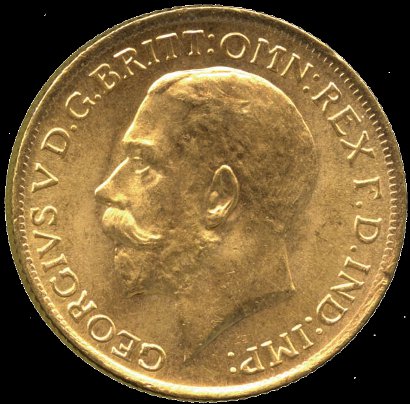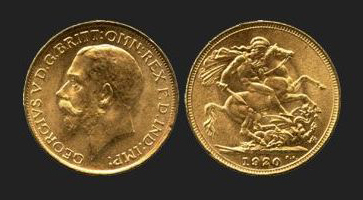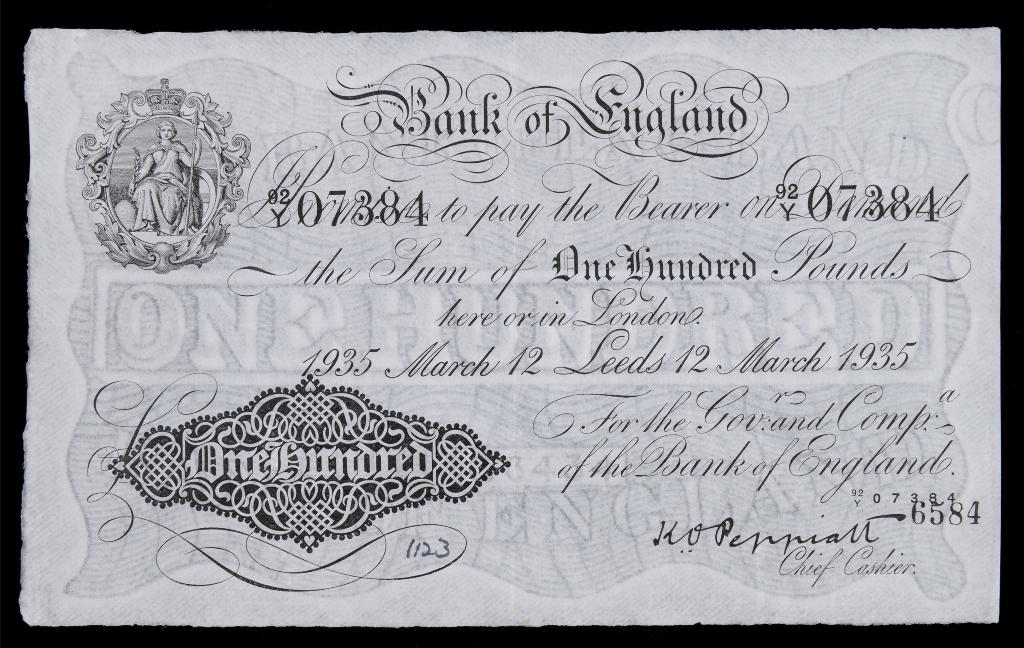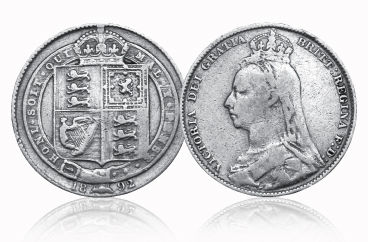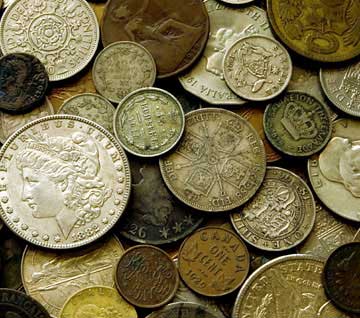Part two sold on the 27th September 2012 for an incredible £2.25m and included the record breaking price of £780,000 achieved for the 1920 Sydney Mint Sovereign
Regarding the 1920 Sydney Mint sovereign Baldwin’s state that:
“the greatest rarity in the Colonial Gold Sovereign Series, most specimens are housed in institutions and this represents an extremely rare opportunity to acquire a piece of numismatic history of the utmost importance.”
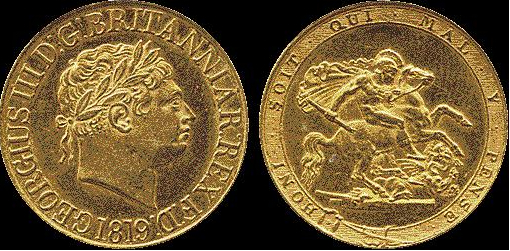
This 1819 gold sovereign of George III is one of maybe eight examples, and is the key date to the sovereign series. The finest known example, it has an estimate of £150,000 to £200,000 (about $228,732 to $304,970 in U.S. funds). – Images courtesy of A.H. Baldwin & Son.
INTRODUCTION
The ultimate collection of Milled British Sovereigns and Colonial Branch Royal Mint Sovereigns and associated issues
The outstanding Bentley Collection began as a casual exploration into the possibility of owning some gold in the form of coin in the late seventies; as gold has always been traditionally viewed as a safe haven in times of economic woe. This quickly became a passionate quest to formulate one of the greatest collections assembled of the British Gold Sovereign. The Sovereign was the denomination that pleased the current owner the most, not only from its stand-point in history as one of the most long-lived, respected and widely distributed gold coins in the world, but also for its pleasing dimensions and size to the eye, being 22mm in diameter, weighing 7.98g and struck in 22 carat gold.
First introduced by King Henry VII (1485-1509), in 1489, the denomination was current throughout the hand-struck hammered Tudor and Stuart periods. In various later guises the denomination was as diversely termed as “Pound”, “Unite”, “Laurel”, and more importantly the staple coin of the 18th Century, the gold “Guinea”. It was the need for a reformation of the Coinage Act in 1816 that led to the introduction of the Modern Gold Sovereign.
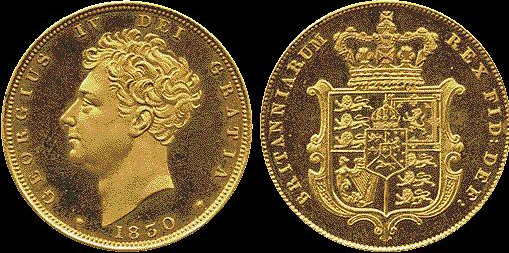
A Proof 1830 gold sovereign of George IV discovered and first sold in 2005 is unique in private hands, and another highlight from the third auction by Baldwin’s of the Bentley Collection. It is estimated at £25,000 to £30,000 ($38,116 to $45,740 in U.S. funds).
Formed over 34 years, the first purchase was made for the embryonic Bentley Collection in 1978, a George V London Sovereign dated 1913. From this foundation coin, the acorn as it were and still in the collection today, a structured and concise “mighty oak” of a collection has blossomed and matured, with an emphasis on quality and unparalleled rarity.
The interest being established by this initial purchase, nurtured a thirst for the best quality from the start. The first aim was to form a complete run of dates, not just those dates usually of a more common bullion nature in top condition, but to take the series of the modern currency Sovereign back to its introduction in 1817 under King George III (1760-1820). It was decided early on to not go back in history any further, as the priority was the modern Sovereign which presented a series with more than enough to concentrate upon, as finding the best state of preservation was paramount. Decimalisation was seen as a fitting close to the collection, as since that time, the regular issue of mint condition sovereigns has perhaps made the denomination too commemorative.
During the latter part of Queen Victoria’s reign (1837-1901), the Royal branch mints began to open in the Colonial Empire; and it was at an early stage that the current owner realised that many of the Gold Sovereigns carry a small mint mark letter either under the bust or shield, or on the ground-line under St George, which indicates which Colonial branch mint that the coin has emanated from. If no letter is apparent it is a London Royal Mint issue. A decision was made to add as many of the dated pieces of these Branch Mints as possible to the collection, from Sydney (1855-1926), Melbourne (1872-1931) and Perth (1899-1931) in Australia; Ottawa (1908-19) in Canada; Bombay in India (1918), and Pretoria in South Africa (1923-32).
Throughout the eighties quality coins began to be added mainly in the currency series, and trusted numismatic contacts with a sharp eye began to be established not just domestically, but on all the continents where the Royal branch mints existed, in the hope of tracking down the rarest and best quality pieces from their respective geographical locations.
It was sometime in this decade that the Victorian Die Number Series of Sovereigns became a further focus for the collection. From 1863 until 1874 inclusive, the Royal Mint in London individually numbered the shield type reverse dies used to strike the currency Sovereigns as a means of “quality control” in assessing the efficiency of use of the dies, and in tracing any weakness in the production process. Some of the dates in this period number over 100 individual dies alone; therefore the scope of the Bentley Collection became even more wide-reaching, and the prospect of collecting anything other than the modern Gold Sovereign never came to fruition. The die number series has only ever been attempted by a handful of previous collectors, and nobody has ever achieved as complete a run in private ownership as demonstrated in the Bentley Collection.
Into the nineties many more important pieces were added as some of the major collections formed in earlier decades began to be dispersed both by private treaty and by public auction. Some of the rarest “Pattern” and “Proof” issues (literally prototypes of coinage) were added to the Bentley Collection during this time. The detail of the collection became therefore even more focused as it became an illustrative history of the gold Sovereign, specialising from gestation in 1816 until decimalisation under Queen Elizabeth II.
During this period it was noted that the South African gold Pond series from the late 19th Century until the Boer War, was of a similar dimension to the gold Sovereign. As it was a short run, relatively speaking, though some varieties very rare, it was decided to add as many of these pieces to the collection, as an interesting forerunner to the British Colonisation of Pretoria.
It was during this period that the crowning piece of the London Royal Mint series was acquired by public auction. The very impressive 1819 Sovereign, the most significant coin in the Bentley Collection was added at the end of the last Century. Still the finest known specimen by far, it is today the most valuable London Sovereign.
Moving into the 21st Century further valuable additions were made to the collection. It did however take until 2006 to find the final date-piece required for the currency part of the collection: the most elusive and coveted of all the Colonial Sovereign Series, the fabled 1920 Sydney Mint Sovereign. This is the crown jewel of the Bentley Collection, sourced from Australia, and is arguably the most valuable currency coin in the entire Australian Series.
The Bentley Collection catalogues will not only form a lasting record of the achievement of the collector, but also an informative reference for the advanced Sovereign connoisseur; a major guide-book to the Sovereign aficionado who is forming a collection; and most importantly a tremendous inspiration to the novice collector of what can be achieved from an initial passing interest in gold bullion as coin. With patience and an appreciation for quality and rarity, it is hoped the future custodians of the coins offered from the Bentley Collection will be able to build similar or perhaps even more complete collections of Sovereigns.
More importantly, the Bentley Collection forms an important historical record of the British Empire for the economic historian and a physical illustration of artistic merit in coin design for the art historian. The Benedetto Pistrucci design of St George slaying the dragon has been the most enduring coin design in the world. Inspired perhaps by the George Noble of King Henry VIII (1509-47), and in its current form for the last 190 years with minimal change, and over this period more often in use than not.
Collections of the calibre of the Bentley Collection only come along once in a numismatic generation and the decision to divide the sale of the collection into three parts has been carefully considered in order to allow Sovereign collectors to plan their proposed purchases properly, with plenty of advance notice of what highlights will be available.
A.H. Baldwin & Sons Ltd are proud to offer the Bentley Collection by auction and we look forward to welcoming one and all to these three numismatic events.
Steve Hill
The third and final part of the Bentley Collection of gold sovereign coins was slated for auction May 8 in London.
A.H. Baldwin & Son calls the collection “the most spectacular and comprehensive assemblage of British gold Sovereigns.”
The final auction offered 307 lots of coins from the Royal Mint in London. Highlighting the auction is the 1819 gold sovereign of George III, the key date of the London sovereigns issued for circulation, with maybe eight known examples in private hands, according to Steve Hill of Baldwin’s.
Records indicated that 3,574 examples of the coin were struck that year, with the public preference for bank notes at the time in England likely to have kept demand low, according to Baldwin’s. Most of the coins are believed to have been removed from circulation by tourists, explaining why so few are known today, according to Baldwin’s.
The sovereign, which traces its history to 1489 as a denomination, in modern times was introduced in 1817 following the Coinage Act of 1816. It did not replace bank notes as the popular medium of payment until certain restrictions were removed by the Bank of England from 1820 to 1823, according to the auction firm.
The rarity of the 1819 coin was recognized as early as 1829, when the Bank of England coordinated a survey with the Royal Mint to test the metal in coins then in circulation and found just two circulated 1819 examples in its holdings, according to Baldwin’s. All of the gold sovereigns struck that year were reportedly made from gold brought to the Royal Mint for conversion from bullion or mined gold into coins.
Six examples of the 1819 coin have been sold publicly, most since Oct. 5, 1998, when the piece now in the Bentley Collection was sold by Sotheby’s for £55,000 including buyer’s fee.
A seventh example was seen (by the Royal Mint, and not at auction) in 1974 but has not been seen since, and an example reportedly struck in Proof was part of the famed John G. Murdoch Collection, which was sold in 1903. The so-called Proof example last surfaced in a 1939 auction; its Proof status cannot be confirmed from the only image known, a 1905 photograph.
No private institutions — including the Royal Mint — appear to have an example, according to Baldwin’s.
The Bentley Collection coin is graded About Extremely Fine by the auction house and, according to Baldwin’s, is the finest example of the 1819 gold sovereign by far (one other approaches Very Fine, with most examples around Poor to Fair or Fine condition). The Bentley coin has an estimate of £150,000 to £200,000 (about $228,732 to $304,970 U.S.).
Another highlight offers even greater rarity, at an estimated price far less than the 1819 sovereign.
The Proof 1830 gold sovereign of George IV was discovered, confirmed by the Royal Mint and sold for the first time publicly in 2005 in a Dix Noonan Webb auction in London, where Baldwin’s parent company, Noble Investments, bought it on behalf of the owner of the Bentley Collection.
The coin features a design engraved by William Wyon after Francis Chantrey’s model, with the head of the king facing left on the obverse. Features distinct to the coin, thus setting it apart from other Proof 1830 examples, are a milled edge (rather than plain) and, on the reverse, eight hearts in the Hanoverian arms (rather seven hearts). When it was sold in 2005, the consignor reportedly had owned it since the 1960s.
Unique in private hands, it is toned and has a few marks but is “as struck.” It has an estimate of £25,000 to £30,000 ($38,116 to $45,740 U.S.).


